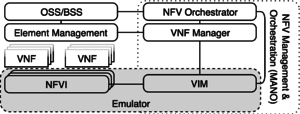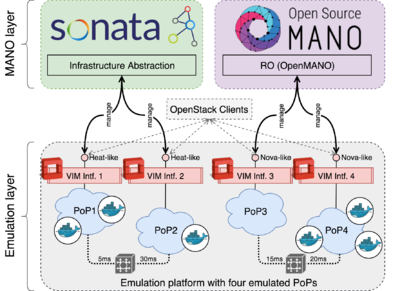VIM emulator: Difference between revisions
| Line 56: | Line 56: | ||
== Additional information and links == | == Additional information and links == | ||
* Main publication: M. Peuster, H. Karl, and S. v. Rossem: [http://ieeexplore.ieee.org/document/7919490/ '''MeDICINE: Rapid Prototyping of Production-Ready Network Services in Multi-PoP Environments''']. IEEE Conference on Network Function Virtualization and Software Defined Networks (NFV-SDN), Palo Alto, CA, USA, pp. 148-153. doi: 10.1109/NFV-SDN.2016.7919490. (2016) | |||
* [https://containernet.github.io Containernet] | |||
* [http://sonata-nfv.eu SONATA NFV] | |||
* [https://github.com/sonata-nfv/son-emu/wiki more dokumentation in the SONATA wiki] | |||
* [https://youtu.be/pFL9wDNOBho Demo Video on YouTube] | |||
Revision as of 13:37, 18 October 2017
Vim-emu: A NFV multi-PoP emulation platform
This emulation platform was created to support network service developers to locally prototype and test their network services in realistic end-to-end multi-PoP scenarios. It allows the execution of real network functions, packaged as Docker containers, in emulated network topologies running locally on the developer's machine. The emulation platform also offers OpenStack-like APIs for each emulated PoP so that it can integrate with MANO solutions, like OSM. The core of the emulation platform is based on Containernet.
The emulation platform vim-emu was previously developed as part of the EU H2020 project SONATA and is now developed as part of OSM's DevOps MDG.
Scope
The following figure shows the scope of the emulator solution and its mapping to a simplified ETSI NFV reference architecture in which it replaces the network function virtualisation infrastructure (NFVI) and the virtualised infrastructure manager (VIM). The design of vim-emu is based on a tool called Containernet which extends the well-known Mininet emulation framework and allows us to use standard Docker containers as VNFs within the emulated network. It also allows adding and removing containers from the emulated network at runtime which is not possible in Mininet. This concept allows us to use the emulator like a cloud infrastructure in which we can start and stop compute resources (in the form of Docker containers) at any point in time.
Architecture
The vim-emu system design follows a highly customizable approach that offers plugin interfaces for most of its components, like cloud API endpoints, container resource limitation models, or topology generators.
In contrast to classical Mininet topologies, vim-emu topologies do not describe single network hosts connected to the emulated network. Instead, they define available PoPs which are logical cloud data centers in which compute resources can be started at emulation time. In the most simplified version, the internal network of each PoP is represented by a single SDN switch to which compute resources can be connected. This can be done as the focus is on emulating multi-PoP environments in which a MANO system has full control over the placement of VNFs on different PoPs but limited insights about PoP internals. We extended Mininet's Python-based topology API with methods to describe and add PoPs. The use of a Python-based API has the benefit that developers can use scripts to define or algorithmically generate topologies.
Besides an API to define emulation topologies, an API to start and stop compute resources within the emulated PoPs is available. Von-emu uses the concept of flexible cloud API endpoints. A cloud API endpoint is an interface to one or multiple PoPs that provides typical infrastructure-as-a-service (IaaS) semantics to manage compute resources. Such an endpoint can be an OpenStack Nova or HEAT like interface, or a simplified REST interface for the emulator CLI. These endpoints can be easily implemented by writing small, Python-based modules that translate incoming requests (e.g., an OpenStack Nova start compute) to emulator specific requests (e.g., start Docker container in PoP1).
As illustrated in the following figure, our platform automatically starts OpenStack-like control interfaces for each of the emulated PoPs which allow MANO systems to start, stop and manage VNFs. Specifically, our system provides the core functionalities of OpenStack's Nova, Heat, Keystone, Glance, and Neutron APIs. Even though not all of these APIs are directly required to manage VNFs, all of them are needed to let the MANO systems believe that each emulated PoP in our platform is a real OpenStack deployment. From the perspective of the MANO systems, this setup looks like a real-world multi-VIM deployment, i.e., the MANO system's southbound interfaces can connect to the OpenStack-like VIM interfaces of each emulated PoP. A demonstration of this setup was presented at IEEE NetSoft 2017.
Installation
Option 1: Bare-metal installation
- Requires: Ubuntu 16.04 LTS
sudo apt-get install ansible git aptitude
Step 1: Containernet installation
cdgit clone https://github.com/containernet/containernet.gitcd ~/containernet/ansiblesudo ansible-playbook -i "localhost," -c local install.yml
Step 2: vim-emu installation
cdgit clone https://osm.etsi.org/gerrit/osm/vim-emu.gitcd ~/vim-emu/ansiblesudo ansible-playbook -i "localhost," -c local install.yml
Option 2: Nested Docker Deployment
This option requires a Docker installation on the host machine on which the emulator should be deployed.
git clone https://osm.etsi.org/gerrit/osm/vim-emu.gitcd ~/vim-emu- Build the container:
docker build -t vim-emu-img . - Run the (interactive) container:
docker run --name vim-emu -it --rm --privileged --pid='host' -v /var/run/docker.sock:/var/run/docker.sock vim-emu-img /bin/bash
Usage example
Additional information and links
- Main publication: M. Peuster, H. Karl, and S. v. Rossem: MeDICINE: Rapid Prototyping of Production-Ready Network Services in Multi-PoP Environments. IEEE Conference on Network Function Virtualization and Software Defined Networks (NFV-SDN), Palo Alto, CA, USA, pp. 148-153. doi: 10.1109/NFV-SDN.2016.7919490. (2016)
- Containernet
- SONATA NFV
- more dokumentation in the SONATA wiki
- Demo Video on YouTube

